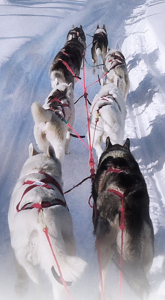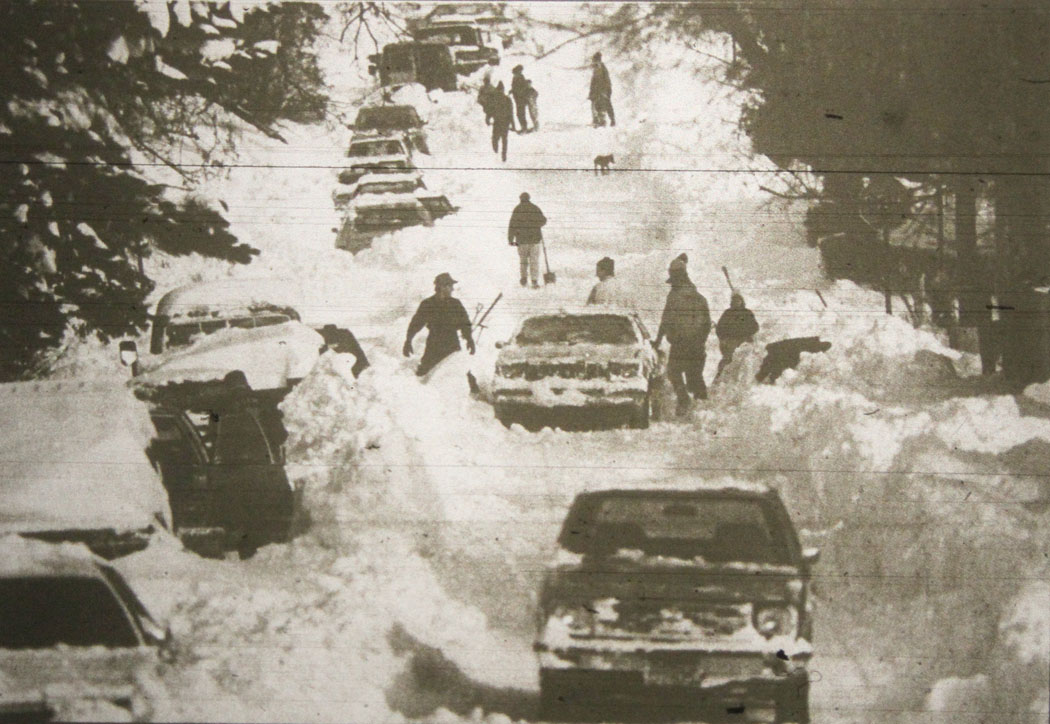Welcome to the first in our series of “Trail In Focus” articles. Every so often we will be posting a “Trail In Focus” piece that tells you everything you would want to know about that trail. We hope you find these articles to be informative and helpful in making your decision on where to plan your next snowmobile outing. For the short term our “Trail In Focus” segments will be confined to the Minnesota Arrowhead- primarily because this is the Northeast Minnesota Snowmobile Blog. In the future, however, we plan on expanding our coverage to other parts of the state and even to trails in other states. As Snowmobiletrail.com grows so shall the amount of information available to our readers.
Appropriately our first Trail In Focus segment tackles one of the most iconic trails in all of Minnesota: The CJ Ramstad North Shore State Trail. The reason I decided to write about the NSST is twofold- first because it is the trail that the staff of snowmobiletrail.com rides on the most, primarily because it literally runs past the back door of our home office, and secondly because without the NSST most of the other snowmobile trails in Northeast Minnesota would not exist.
HISTORY
To fully appreciate the importance of the NSST, one must go back to the 1960′s. The invention of the modern snowmobile suddenly gave the average Minnesota family a fun new wintertime activity to partake in. Snowmobile sales in Minnesota were growing in leaps and bounds- the first golden age of snowmobiling was beginning. By 1967 the Minnesota state legislature decided that snowmobiles needed to be regulated and licensed like cars and boats. The DNR was charged with regulating this new winter activity. As the number of snowmobiles increased so did their reach into what had been inaccessible areas. Suddenly power lines, roadside ditches, golf courses, hiking trails, and your neighbor’s back yard were now popular snowmobile routes. Chaos reigned. The Minnesota State legislature again stepped to the plate proposing a number of state funded multi use trails that were primarily designed to be used as snowmobile trails. The state would create roughly one thousand miles of trails and they would also approve a Grant In Aid program that would allow the DNR to work with local snowmobile clubs to work with land owners to build other trails. The thought was that the one thousand miles of state trail would result in other access type trails being built that would hook up with the new state trails creating a vast state wide network. In 1975 the authorization to begin the North Shore State Trail was granted. At that time parts of the trail had already been in use since 1971. Sections of the trail were built over the same routes that explorers had used when they first arrived in Minnesota along with old logging roads and old railroad grades. At the time the trail was being built the average top speed of a snowmobile was between 40 and 50 MPH. This accounts for parts of the trail having some very sharp turns- just fine in the seventies but a little more challenging for the sleds of today. The original planners of the trail could never have anticipated the enormous boom that would take place in the snowmobile market during the 1990′s. Nor could they have anticipated that their 1,000 miles of trail would lead to 21,000 miles of GIA trails giving Minnesota more miles of snowmobile trails than any other state. When proposing the trail the legislators anticipated the trail to accommodate ten or twenty thousand snowmobiles a year but with the advancements in technology and the extended riding season up north the trail routinely sees over one hundred thousand sleds each winter. In 2009 The North Shore State Trail was renamed The CJ Ramstad North Shore State Trail in honor of magazine publisher CJ Ramstad who was killed in a tragic car accident in 2007 along with his son. CJ’s efforts promoting the sport of snowmobiling worldwide were instrumental in helping the sport reach the high level of popularity it enjoys today.
THE TRAIL
Martin Rd To The Gravel Pit: The trail begins in a parking lot off of Martin Rd in Duluth, It is also the spot where it connects with the very first of the feeder trails- The East Duluth Trail system. The East Duluth Trails serve as a conduit for the residents of the Eastern half of Duluth to escape up the shore. This first section of trail is the one most cluttered by road crossings and twists and turns. It is narrow in many areas and has the general terrain changes of a typical “in town” type of trail and there is nothing really spectacular about it. This section of trail was created to give the residents o Duluth access to escape to the North and that is exactly what it does. It is an extremely busy section of trail as it serves not only the Duluth Populace but many riders from southern Minnesota who trailer their sleds to the Arrowhead.
The Gravel Pit to Two Harbors: The gravel pit is where the Reservoir Lakes Trail from Island Lake dumps its share of snowmobilers onto the NSST. This is where the rest of the traffic from Duluth and the surrounding area converge. Occasionally there are fires and hot dog feeds at this intersection which is one of the busiest trail intersections in the state. You can also access the trail from the nearby parking lot off of Normana Rd. The section from here to Fox Farm Road is characterized by very hilly terrain and is an extremely popular section of trail for riders in the know. Although the terrain and nature of the trail here tempts you to ride on the very edge of the 50 MPH speed limit, please exercise caution on these hills as you never know what can be over the crest. Every year there are some crashes and rollovers in this section of trail caused by people pushing themselves a little past their abilities and finding surprises over the hilltops, including one rider who crested a hill and came face to face with a groomer- the groomer won. Have fun but use your head. After Fox Farm Road the terrain begins to flatten out as you get closer to the Two Harbors West and East Corridor Trails
East Corridor/ Yukon Trail Intersection to Finland: When you hit Two Harbors it is intersections galore- the Yukon Trail, and the Two Harbors Corridor trail all dump a ton of traffic onto the trail at this point along with the Alger parking lot off of County Highway 2. This is a popular starting point for a lot of people coming up from the cities who don’t want to shack up in Duluth. There are also accommodations in Two Harbors for people to spend the night- some of them right off of the Corridor trails. All of this makes this a busy spot. The trail mellows out a bit here following some logging roads and old rail road grade. The real story is all of the feeder trails in this section- The Yukon, the Gooseberry, all of these trails are either spectacular in themselves or bring you to a fantastic destination. As you get closer to Finland the elevation begins to change and then your options get crazy- Moose Walk Trail, Timberwolf Trail and all of the trails leading into Silver Bay. Any of these trails are great places to explore and the trails in and out of Silver Bay bring you to some of the most incredible views of Lake Superior in all of Minnesota- If you ride up here you’d better have a camera with you or you will be kicking yourself. The County Road 7 lot is another popular jumping off point for people trailering from the south and west. Finland is the halfway point for those running the entire length of the trail from Duluth to Grand Marais and it’s a perfect fueling location. If your fuel range is 75 miles or more you can gas up here and get to Duluth or Grand Marais. If you have an Arctic Cat 800- well it’s just another place to get gas!
Finland to Lutsen: This section of trail is characterized by its nice wide sections that run through a variety of terrain and forests. You get it all here- some fantastic rolling hills, long straight shots, hardwwod forests, pine forests, open fields everything you could want all thrown together and traversed by wide trails with gradual turns. Some members of the snowmobiletrail.com staff rate this as their favorite section of trail to ride and we visit it repeatedly throughout the season. This section boasts numerous spur trails that drop you down to the Lake Superior shorline. This is one of the ironies of the North Shore State Trail- it doesn’t really run along the North Shore at all- it spends nearly all of its time in the snowy higher elevations far inland. There are two major feeder trails on this stretch. About 16 miles past Finland you find the iconic Tomahawk Trail considered by many to be the best trail in all of Minnesota. After that it seems there are trails tapping in from the west or dropping down to the lake every few miles until you get to the Lutsen Trail- If you need anything this is the trail to take because you are about to enter an area of high elevation and a lot of snow and very little in the way of civilization.
Lutsen to Grand Marais: Once you’ve passed Lutsen Trail it’s almost like being in a movie. There is one more offshoot that brings you back down to Lutsen as if to say “This is it! Last chance! You are now passing the point of no return!” Once you pass that trail you are in the wilderness. There is nothing between here and Grand Marais but spectacular views and gorgeous trails cut through miles of endless pine forest. Every offshoot of this trail is just another trail through the wilderness including the Gunflint Trail which brings you to some of the most remote places in Minnesota. There aren’t many road crossings or gas stations or anything else up here- just other snowmobilers. If you want to get away from everything this is the place to do it. Finally the trail ends in Grand Marais. If you are in Grand Marais in the wintertime you will feel as if the city was built for snowmobilers- everything is geared toward the snowmobiler and the trail literally runs down the side of the street brining you to hotels, restaurants and gas stations. It’s very common to see more sleds than cars. One of the most interesting things about leaving Grand Marais is that the trail from downtown to the top of the hill is almost a straight shot and you climb about 1,000 feet in elevation. You can definitely notice the change in snow quantity as you climb ever higher. There aren’t many places in Minnesota where you can witness such a dramatic climactic change in such a short amount of time- it is a seldom noticed but wonderful aspect of this trail.
In conclusion if you haven’t ridden the CJ Ramstad North Shore State Trail then you are missing out on one of the jewels of the state. I would recommend it to everyone that has ever ridden a snowmobile. If you are looking for rugged beauty and lots of snow this is where you will find it.



